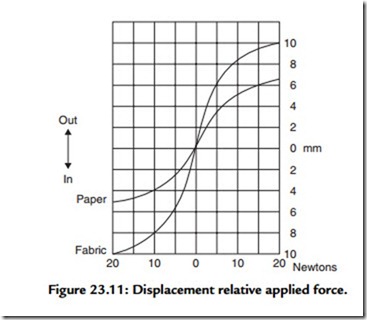Soft Domes
For use at medium and high frequencies, the “soft dome” system has found favor. It consists of a preformed fabric dome with integral surround and usual voice coil assembly. It is very light and its rigidity can be controlled by the amount of impregnant, but the beauty of the concept is that the damping can be adjusted by the quantity and viscosity
of the “dope” applied to the dome. Responses flat ±1 dB to 20 kHz are standard, even on inexpensive mass-produced units!
Suspensions
The purpose of suspensions is to provide a known restoring force to the diaphragm/voice coil assembly and at the same time to have sufficient lateral rigidity to prevent any side-to-side movement of the system. This latter requisite is most important when it is remembered that the clearance between the voice coil and the magnet pole pieces is of the order of 0.15 mm for tweeters and 0.4 mm for 150-W woofers. The average domestic 200- mm (8-inch) loudspeaker is about 0.25 mm.
The combined stiffness of the front and rear suspensions is formulated to resonate with the total moving mass of the diaphragm/voice coil assembly and air load to the designed LF resonance. The front suspension radial width is usually about half that of the rear (in order to maximize cone diameter for a given cradle size) and it is this factor that limits the peak-to-peak displacement. Figure 23.11 shows displacement/force for a roll surround. It will be seen that the maximum linear movement is limited: it follows the familiar hysteresis curve of nonlinear dissipative systems.
The annulus of the diaphragm can either be an extension of the cone material itself or, as is more usual with high-fidelity loudspeakers, be a highly compliant surround produced from cotton or man-made fibers, neoprene, or plasticized PVC. In the case of woven materials, these must be sealed and the sealant is usually used to provide some mechanical termination of the cone.
The front suspension represents a discontinuity in the diaphragm system and because it has its own mass and compliance, it is capable of a separate resonance. When this takes place it presents a very high impedance to the edge of the cone, reducing its output and causing a dip in the response. Because of its nonlinearity, it radiates considerable distortion, especially at low frequencies where the amplitude is greatest. The requirements are high flexibility and high interval losses. Probably the most successful material is plasticized PVC, using a very stable nonmigrant plasticizer such as dibutyl sebacate.
The rear suspension is the major restoring force, the radial width is usually at least twice that of the front suspension, and is a multiroll concentrically corrugated fabric disc, impregnated with a phenolic resin. The weave of the material, number of corrugations, diameter, and amount of impregnant determine the stiffness. It should provide a substantially linear restoring force over the designed maximum amplitude of displacement. The whole structure behaves mechanically as a series resonant circuit. The mass is determined by the weight of the cone, voice coil, and former, and the stiffness by the combined effects of the rear suspension and the annulus, the Q of the circuit being determined almost wholly by the losses of the restoring force.
